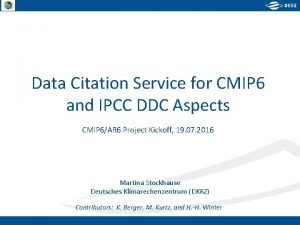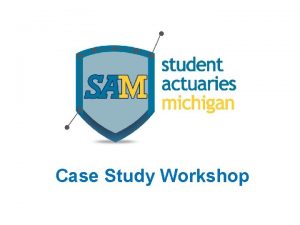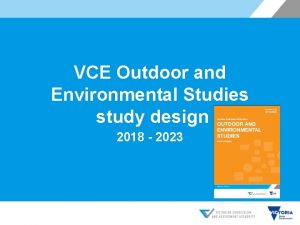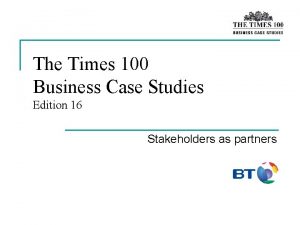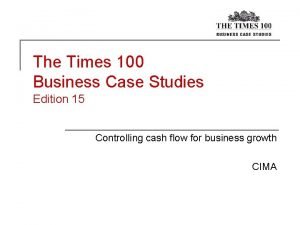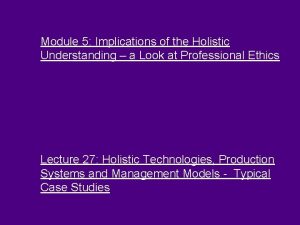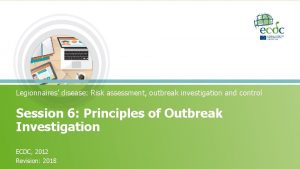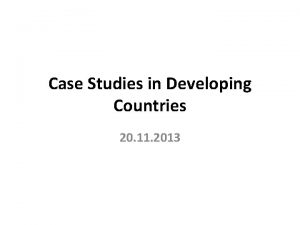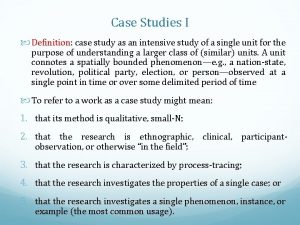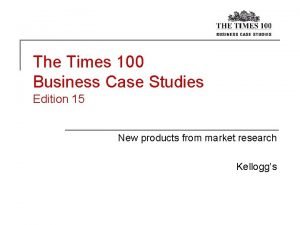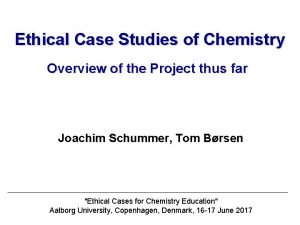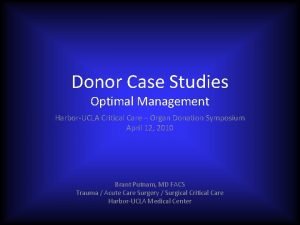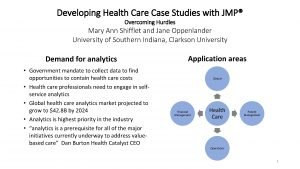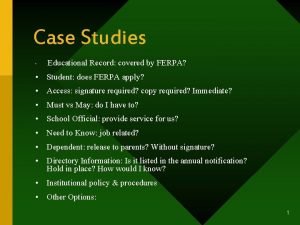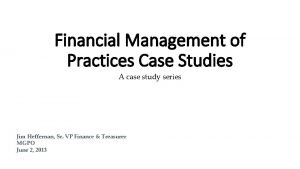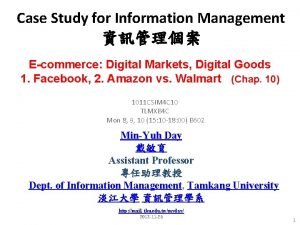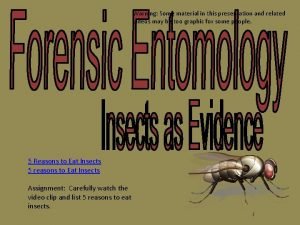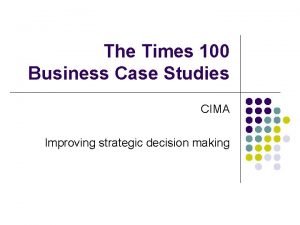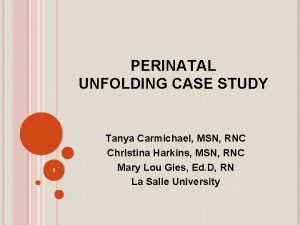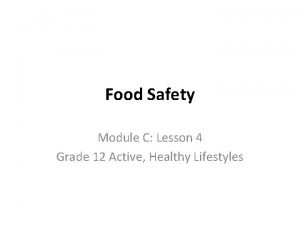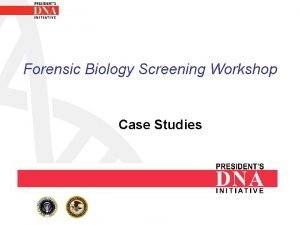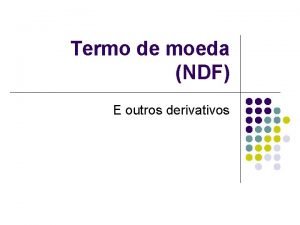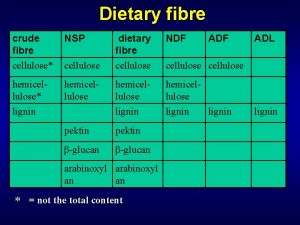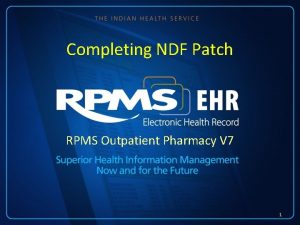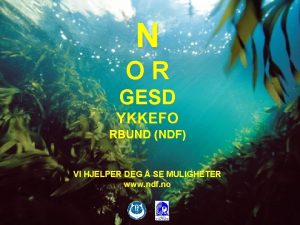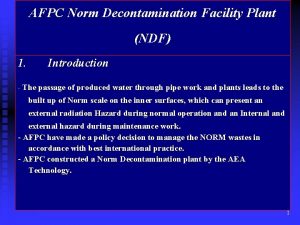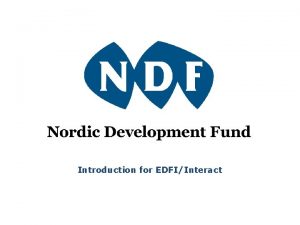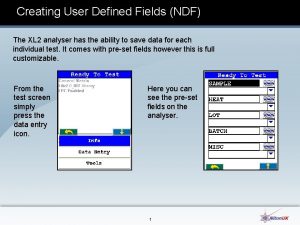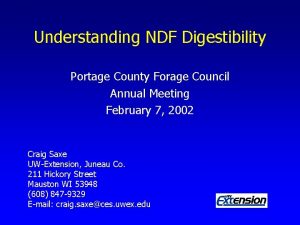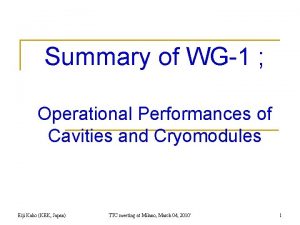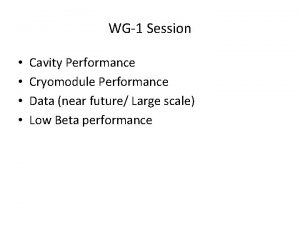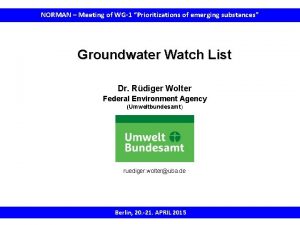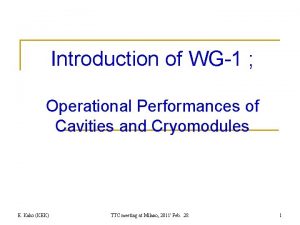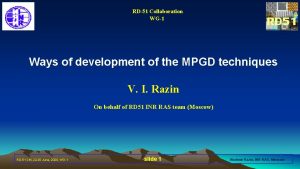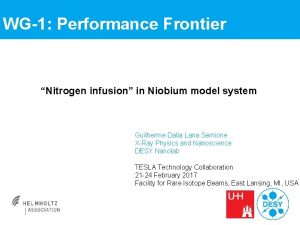NDF WORKSHOP CASE STUDIES WG1 Case Study 6















































- Slides: 47

NDF WORKSHOP CASE STUDIES WG-1, Case Study 6 Genus-level Approach to Taxus Species Ken Farr, CITES Scientific Authority, Natural Resources Canada, Canadian Forest Service 1

Case Study Intent • Purpose of is not to describe a specific nondetrimental finding procedure applicable to all Taxus spp. • Case study presents an approach to sustainable harvest of the species Taxus canadensis • Intent is to inform a discussion around making of non-detrimental findings for other Taxus species 2

Case Study: Placement? • Initial question: Does this NDF case study belong in Trees Working Group? “Yes”, because … • Involves a long-lived understorey woody species • An example of a challenge facing forest managers: reconcile timber and non-timber resource demands • sustainable approach requires knowing “For what do you wish to manage? ” 3

Taxus: Classification • Classification of species in the genus Taxus “notoriously difficult” • “One species with numerous varieties” (Pilger, 1903) • “Twenty-four species, 55 varieties” (Spjut, R. W. 1999). • CITES (Farjon, 2001): 10 species, 3 infraspecific taxa within the genus • 5 CITES Appendix II listed spp. (Asia) • 5 non-listed (Europe and North America) 4

Classification CITES Appendix II-Listed Species IUCN Status • Taxus chinensis (LR/lc) • Taxus cuspidata LR/lc • Taxus fuana Vulnerable (VU D 2) • Taxus sumatrana LR/lc • Taxus wallichiana Data Deficient (DD) 5

Classification CITES Non-Listed Species IUCN Status • Taxus baccata L. LR/lc • Taxus brevifolia Lower Risk Near Threatened • Taxus canadensis LR/lc • Taxus floridana Critically Endangered CR B 1+2 c • Taxus globosa LR/nt 6

Distribution Global Distribution, Genus Taxus (Earle, 2008). 7

Global Population • North American spp. : “isolated individuals in discontinuous populations” • Asian spp. “scattered individuals under the canopy of other trees rather than as dominant species” • Main threats to populations: habitat loss/degradation (human induced) & harvesting 8

Morphology T. canadensis T. baccata x T. cuspidata = T. x media 9

Biological Characteristics • Non-resinous, evergreen gymnosperms (Pinophyta) • Slow-growing, shade-tolerant understorey plants • Many species reported as extremely slow-growing, long lived, taking 100 years or more to attain appreciable size • Lateral branches well developed, similar to leading shoots (of interest in biomass collection) 10

Biological Characteristics • T. wallichiana (Himalayan yew) reported to reach 20 (30) m with dbh to 1 (1. 5) m • T. canadensis (Canada yew) a sprawling multistemmed shrub rarely exceeding 2 m • Numerous yew cultivars exist; exhibit distinct morphological variance in growth form, habit and needle form and colour 11

Biological Characteristics T. x media ‘Hicksii’ 12

UTILIZATION AND TRADE • Biomass (leaves, twig, bark, roots) of all Taxus species contains a unique class of diterpenoid alkaloids (taxanes) • Since the 1990 s, phenomenal pharmaceutical demand for paclitaxel other taxane compounds • paclitaxel (trade name Taxol), used to treat a range of human cancers 13 and

UTILIZATION AND TRADE • Approximately 30, 000 kg of Taxus biomass required to produce 1 kg of refined paclitaxel • Estimated 400 kg per year of paclitaxel products marketed annually in North America and Europe, global market estimated at 800 -1000 kg (2001) • World sales of Paclitaxel in 2003 estimated at $4. 2 billion US, were expected to grow to $13 billion US by 2008 14

UTILIZATION AND TRADE • Demand for Taxol in North America and Europe in 2002 estimated to require 12, 000 kg of Taxus biomass • Large paclitaxel production facilities exist worldwide, including facilities in India, China, North America and Europe • Import and export of biomass of one or another Taxus spp. is largely a function of supply and cost 15

UTILIZATION AND TRADE • Demand for Taxol in North America and Europe in 2002 estimated to require 12, 000 kg of Taxus biomass • Large paclitaxel production facilities exist worldwide, including facilities in India, China, North America and Europe • Import and export of biomass of one or another Taxus spp. is largely a function of supply and cost 16

COMMODITY IN TRADE • Taxus biomass sometimes exported as dried needles and twigs • More often as crude liquid or powdered extracts of varying concentrations • Chemical extracts in trade vary from “brown liquor” shipped in drums to whitish powder • Pure paclitaxel is a whitish or yellowish, crystalline material 17

HARVEST METHODS Harvest of Bark • • Bark from T. brevifolia (Pacific yew) was the first identified source of paclitaxel 10, 000 kg of Pacific yew bark required to make 1 kg of Taxol Bark from 52 000 to 78 000 yew trees harvested annually during the early 1990’s By definition destructive, approach discontinued in 1993 by producer (Bristol Myers Squib) 18

HARVEST METHODS Harvest of Leaf and Twig Biomass • Taxanes found to occur in the stem bark, roots and needles of other yew species e. g. T. wallichiana (Himalayan yew) • Emerged as an alternate harvesting approach that had potential to support repeatable and sustainable harvesting 19

Example, T. canadensis • Management approach here presented is specific to one non-CITES listed sp. (T. canadensis) • Historically, species was not seen as commercially important, largely missed in forest resource inventories * • * Will be captured in “next generation” forest inventories 20

Example, T. canadensis Distribution, Taxus canadensis 21

Management History • Early 1990’s, sudden interest in T. canadensis as an alternative source of income for rural communities • Lead, initially, to excessive and biologically unsustainable harvesting practices • Experience suggested unlimited harvesting in the accessible parts of sp. range could result in localized commercial extinction 22

Harvest Guidelines, Principles • Response: formation of an ad hoc Working Group (Canadian Ground Hemlock Working Group) • Comprised of Canadian Federal and Provincial forestry officials, private sector growers, harvesters and paclitaxel producers • Worked together to establish voluntary harvesting guidelines, principles, corresponding criteria and indicators 23

Harvest Guidelines, Principles Guidelines and principles were intended to address: • adherence to applicable provincial and federal legislation and international treaties • conservation of biodiversity, soil and water on harvest sites • monitoring and tracking to ensure harvesting met sustainability 24

Harvest Guidelines, Principles • Guidelines focused on the level of harvest intensity that can reasonably be employed if full regeneration of the harvested population is expected • Initial guidelines suggested removal of 4 or 5 years of growth was ‘biologically’ acceptable • View was based on provision plants would not be re-harvested for period of time equal to, or longer than, the number of years of growth extensions removed 25

Harvest Guidelines, Principles • Guidelines focused on the level of harvest intensity that can reasonably be employed if full regeneration of the harvested population is expected • Initial guidelines suggested removal of 4 or 5 years of growth was ‘biologically’ acceptable • View was based on provision plants would not be re-harvested for period of time equal to, or longer than, the number of years of growth extensions removed 26

Harvest Guidelines, Principles • Subsequent research and harvest trials suggested plants require a period of time significantly longer than 5 -6 years to recover • Physiological research, field testing determined optimum sustainable harvest level is removal of not more than 3 years of growth (i. e. 3 most current seasonal growth extensions) from any stem • Revised guidelines reflected discussions among harvesters and harvest contractors 27

Harvest Guidelines, Principles Significant point: • Biomass harvest limits are applied directly to individual stems, rather than indirectly to (e. g. ) volume of biomass per unit of harvested land area • Guidelines are applied on Crown (publicly owned) lands in two Canadian provinces, part of legal framework in one province 28

Harvest Guidelines, Principles Guidelines Also Consider: • Timing of harvest • Selection of plants for harvest (minimum plant size) • Stem retention (one in five) • Harvesting methods (tools, procedures) • Optimum time between harvests (4 years) 29

Harvest Guidelines, Principles establish best practices and ‘code of conduct’ i. e. : • • Adhere to legal frameworks Maintain viability of natural populations Conserve the quality and quantity of biomass Ensuring conservation of biodiversity, soil, water and other ecosystem attributes 30

Legal Framework • In Canada, conservation of wild species is multi -jurisdictional, under authority of various provincial, territorial, and federal acts related to wildlife management • Specific regulation of T. canadensis harvest varies by jurisdiction 31

NDF Considerations • Linkage of harvest intensity to a physiologically -based rate of annual stem growth is a transferable method for informing nondetriment determination • Stem-specific control approach is an “allowable cut” estimation that, if verifiable, ensures nondetrimental harvest 32

NDF Considerations Additional monitoring and control methods employed: • requirements for harvest site mapping and reporting • mandatory training and licensing of biomass harvesters and sellers • chain-of-custody and transport controls • limit of legal biomass export and import to licensed buyers 33

NDF Considerations • Linkage of harvest intensity to a physiologically -based rate of annual stem growth should be a transferable method for informing nondetriment determination • Use of stem-specific measurements in harvest guidelines can serve to reduce regulatory burdens (i. e. ) regulation by area, volume 34

NDF Considerations • Process here described a response to sudden, unexpected, uncontrolled and unsustainable demand pressure on an understorey species outside mainstream forest management • In such situations, botanical and ecological data, forest classification data, modeling, may be required as short-term replacement for detailed forest resource inventories 35

NDF Considerations 36

NDF Considerations 37

NDF Considerations 38

Considerations for NDFs 39

Considerations for NDFs 40

Considerations for NDFs 41

Considerations for NDFs • T. canadensis bio-map (climate and digital elevation modeling using ANUCLIM) 42

Economic Considerations • Stem-specific harvest limits contained in the guidelines can produce measurable economic advantages for harvesters • Positive economic outcomes are linked to quality and quantity of product (taxanes) in biomass harvested, and to reduced travel, transport and operating costs 43

Considerations for NDFs • Process here described arose from a “wild west” situation … sudden, uncontrolled and unsustainable pressure on species • In such cases, what is minimum information required for making an NDF? • Full adherence to guidelines that evolved for T. canadensis (a sustainable stem-specific harvest) would equate (functionally) to a NDF 44

Considerations for NDFs • Case study is about management (therefore not an NDF) but was based on an NDF ‘finding’ − a harvest limit based on a species specific morphology, physiology • Inclusive approach (regulators, harvesters, buyers, commodity producers) was a component of success 45

Considerations for NDFs • Global NTFP market (pharmaceuticals) evolves, relocates more rapidly than fibre market − ability to consider, produce NDF’s quickly required • NTFP and traditional forest management approaches increasingly linked … (a challenge for managers and Scientific Authorities) • Final point for consideration … sustainable harvest does not equate to sustainable forest management 46

NDF WORKSHOP CASE STUDIES WG-1, Case Study 6 Genus-level Approach to Taxus Species Ken Farr, CITES Scientific Authority, Natural Resources Canada, Canadian Forest Service 47
 Lta
Lta Guesstimate market sizing
Guesstimate market sizing Paradigm shift from women studies to gender studies
Paradigm shift from women studies to gender studies Foxmeyer erp failure case study
Foxmeyer erp failure case study Best worst and average case
Best worst and average case Capte self study workshop
Capte self study workshop Outdoor education study design
Outdoor education study design Legal studies study design 2021
Legal studies study design 2021 Vce theatre studies study design
Vce theatre studies study design Advantages of descriptive research
Advantages of descriptive research Times 100 business case studies
Times 100 business case studies Times 100 case studies
Times 100 case studies Case studies of typical holistic technologies
Case studies of typical holistic technologies Advantages and disadvantages of case control studies
Advantages and disadvantages of case control studies Prospective and retrospective difference
Prospective and retrospective difference Gdpr case studies
Gdpr case studies Gcse geography case studies
Gcse geography case studies Daniel james euthanasia
Daniel james euthanasia E procurement case studies
E procurement case studies Types of case studies
Types of case studies Definition of case study
Definition of case study The times 100 business case studies
The times 100 business case studies Nasa case study
Nasa case study Abo discrepancy
Abo discrepancy Chemistry ethics case studies
Chemistry ethics case studies Nspe board of ethical review cases
Nspe board of ethical review cases Organ donation case studies
Organ donation case studies Jmp case studies
Jmp case studies Case studies of rtos
Case studies of rtos Ferpa case studies
Ferpa case studies Social engineering case studies
Social engineering case studies Plagiarism
Plagiarism Financial management case study
Financial management case study Digital marketing case studies 2012
Digital marketing case studies 2012 Crime solving insects answer key
Crime solving insects answer key The times 100 business case studies
The times 100 business case studies Ref impact case studies
Ref impact case studies Bubblehep
Bubblehep Food safety errors: case studies
Food safety errors: case studies Growth hacking case studies
Growth hacking case studies Case study base
Case study base What is case series
What is case series Retrospective cohort study
Retrospective cohort study Work study and method study
Work study and method study Marty lobdel
Marty lobdel Study to study
Study to study Difference between time study and motion study
Difference between time study and motion study Time and motion study example ppt
Time and motion study example ppt
